Impact of Brittle Creep Failure on Time-Delayed Characteristics of Rockburst
Abstract
:1. Introduction
2. Theoretical Models
2.1. Analytic Model for Deep Tunnel Section
2.1.1. Elastic Analytic Model for Deep Tunnel Section
2.1.2. Elastoplastic Analytic Model for Deep Tunnel Section
2.1.3. Stress State on Key Positions
2.2. Creep Model
2.2.1. Micromechanical Model
2.2.2. Strain vs. Time
2.3. Mechanical Properties on Macro- and Micro-Scales
3. Time-Dependent Evolution of Crack Length and Strain
4. Time-Delayed Failure for Surrounding Rock in Deep Tunnel
4.1. Theoretical Illustration
4.2. Numerical Illustration
5. Concluding Remarks
- Due to the high damage accumulation by the developed crack evolution during the creep inside the surrounding rock, the time-delayed rockburst is easy to trigger within a short time, if the valid support for the excavation surface of the deep tunnel is not set promptly after excavation unloading.
- The surrounding rock in the plastic state area presents more instability than that in the elastic status zone. The surrounding rock on the excavation border failed in 2.7 h and with the growing distance from the center of tunnel section, the creep duration reached three years on the plastic area boundary until the stress field achieved balance as the distance reached infinite.
- The significant increasing tendency was exhibited by delayed failure duration when the tunnel excavation radius was 6.5 m at the depth of 1900 m, ranging from the excavation surface (4.6 h) to the interface (21.5 years) between the SEDZ and WEDZ. The surrounding rock in the SEDZ of which the maximum scope reached 0.65 m was more unsteady than that in the WEDZ, where the area close to the excavation edge most easily induced the brittle creep failure in a brief period.
- Both the increasing radius of the tunnel cross section ranging from 4 to 10 m and the higher in situ stresses around the opening at depth (2400 m) accelerated the time-delayed failure of the surrounding rock in the SEDZ. The local high stress concentration area formed by the irregular cross-section shape resulted in the expansion of the damage zone and the decrease in the time-delayed failure duration.
Author Contributions
Funding
Institutional Review Board Statement
Informed Consent Statement
Data Availability Statement
Conflicts of Interest
References
- Brown, E.T. Progress and challenges in some areas of deep mining. Min. Technol. 2012, 121, 177–191. [Google Scholar] [CrossRef]
- Feng, X.T.; Chen, B.R.; Ming, H.J. Studies on the evolution process of rockbursts in deep tunnels. J. Rock Mech. Geotech. Eng. 2012, 4, 289–295. [Google Scholar] [CrossRef]
- Farhadian, H. A new empirical chart for rockburst analysis in tunnelling: Tunnel rockburst classification (TRC). Int. J. Min. Sci. Technol. 2021, 31, 603–610. [Google Scholar] [CrossRef]
- Zhang, J.J.; Fu, B.J. Rockburst and its criteria and control. Chin. J. Rock Mech. Eng. 2008, 27, 2034–2042. (In Chinese) [Google Scholar] [CrossRef]
- Zhao, X.J.; Chen, B.R.; Zhao, H.B.; Jie, B.H.; Ning, Z.F. Laboratory creep tests for time-dependent properties of a marble in Jinping II hydropower station. J. Rock Mech. Geotech. Eng. 2012, 4, 168–176. [Google Scholar] [CrossRef] [Green Version]
- Li, X.Z. Micromechanics-Based Study on the Progressive and Creep Failure Properties of Brittle Rocks. Ph.D. Thesis, Xi’an University of Architecture and Technology, Xi’an, China, 2016. (In Chinese). [Google Scholar]
- Chen, H.Z.; Shao, Z.S.; Fujii, Y. An experimental investigation on the creep behavior of deep brittle rock materials. Materials 2022, 15, 1877. [Google Scholar] [CrossRef] [PubMed]
- Chen, B.R.; Feng, X.T.; Ming, H.J.; Zhou, H.; Zeng, X.H.; Feng, G.L.; Xiao, Y.X. Evolution law and mechanism of rockburst in deep tunnel: Time delayed rockburst. Chin. J. Rock Mech. Eng. 2012, 31, 561–569. (In Chinese) [Google Scholar]
- Li, Z.H. The Formation and Evolution Mechanism of Excavation Damaged Zone under Deep Tunnel Excavation. Ph.D. Thesis, Northeastern University, Shenyang, China, 2013. (In Chinese). [Google Scholar]
- Main, I.G. A damage mechanics model for power-law creep and earthquake aftershock and foreshock sequences. Geophys. J. Int. 2000, 142, 151–161. [Google Scholar] [CrossRef] [Green Version]
- Amitrano, D.; Helmstetter, A. Brittle creep, damage and time to failure in rocks. J. Geophys. Res. Solid Earth 2006, 111, B11201. [Google Scholar] [CrossRef] [Green Version]
- Fu, T.F.; Xu, T.; Heap, M.J.; Meredith, P.G.; Mitchell, T.M. Mesoscopic time-dependent behavior of rocks based on three-dimensional discrete element grain-based model. Comput. Geotech. 2020, 121, 103472. [Google Scholar] [CrossRef]
- Nicolas, A.; Fortin, J.; Regnet, J.B.; Verberne, B.A.; Plümper, O.; Dimanov, A.; Spiers, C.J.; Guéguen, Y. Brittle and semibrittle creep of tavel limestone deformed at room temperature. J. Geophys. Res. 2017, 112, 4436–4459. [Google Scholar] [CrossRef]
- Uchita, Y.; Yoshita, T.; Urayam, M.; Hikarawa, Y. Rock behavior observed by means of borehole television camera during a large underground cavern excavation. J. Civ. Eng. Jpn. 1995, 1995, 33–41. [Google Scholar] [CrossRef] [Green Version]
- Martin, C.D.; Kaiser, P.K.; Mccreath, D.R. Hoek-Brown parameters for predicting the depth of brittle failure around tunnels. Can. Geotech. J. 1999, 36, 136–151. [Google Scholar] [CrossRef]
- Li, S.J.; Feng, X.T.; Li, Z.H.; Zhang, C.Q.; Chen, B.R. Evolution of fractures in the excavation damaged zone of a deeply buried tunnel during TBM construction. Int. J. Rock Mech. Min. Sci. 2012, 55, 125–138. [Google Scholar] [CrossRef]
- Siren, T.; Kantia, P.; Rinne, M. Considerations and observations of stress-induced and construction-induced excavation damage zone in crystalline rock. Int. J. Rock Mech. Min. Sci. 2015, 73, 165–174. [Google Scholar] [CrossRef]
- Martino, J.B.; Chandler, N.A. Excavation-induced damage studies at the underground research laboratory. Int. J. Rock Mech. Min. Sci. 2004, 41, 1413–1426. [Google Scholar] [CrossRef]
- Zhang, Z. Numerical Investigation of Formation Mechanism and Process on Excavation Disturbed Zone (EDZ) of Tunnel. Ph.D. Thesis, Northeastern University, Shenyang, China, 2007. (In Chinese). [Google Scholar]
- Tao, M.; Hong, Z.X.; Peng, K.; Sun, P.W.; Cao, M.Y.; Du, K. Evaluation of excavation-damaged zone around underground tunnels by theoretical calculation and field test methods. Energies 2019, 12, 1682. [Google Scholar] [CrossRef] [Green Version]
- Zhang, Z.Z.; Gao, F.; Shang, X.J. Rock burst proneness prediction by acoustic emission test during rock deformation. J. Cent. South Univ. 2014, 21, 373–380. [Google Scholar] [CrossRef]
- Zhou, X.P.; Peng, S.L.; Zhang, J.Z.; Qian, Q.H.; Lu, R.C. Predictive acoustical behavior of rockburst phenomena in Gaoligongshan tunnel, Dulong river highway, China. Eng. Geol. 2018, 247, 117–128. [Google Scholar] [CrossRef]
- Dou, L.M.; Cai, W.; Cao, A.Y.; Guo, W.H. Comprehensive early warning of rock burst utilizing microseismic multi-parameter indices. Int. J. Min. Sci. Technol. 2018, 28, 767–774. [Google Scholar] [CrossRef]
- Liu, G.F.; Jiang, Q.; Feng, G.L.; Chen, D.F.; Chen, B.R.; Zhao, Z.N. Microseismicity-based method for the dynamic estimation of the potential rockburst scale during tunnel excavation. Bull. Eng. Geol. Environ. 2021, 80, 3605–3628. [Google Scholar] [CrossRef]
- Gong, F.Q.; Luo, Y.; Li, X.B.; Xi, X.F.; Tao, M. Experimental simulation investigation on rockburst induced by spalling failure in deep circular tunnels. Tunn. Undergr. Space Technol. 2018, 81, 413–427. [Google Scholar] [CrossRef]
- Yang, Y.S.; Zhou, H.; Zhang, C.Q.; Zhang, K.; Yan, F. Experimental investigation on time-lag failure properties of marble under uniaxial compressive test. Chin. J. Rock Soil Mech. 2011, 32, 2714–2720. (In Chinese) [Google Scholar]
- Xiang, Y.Y. General Theory of Tunnel Mechanics; Science Press: Beijing, China, 2014. (In Chinese) [Google Scholar]
- Zhou, D.; Zhao, Z.H.; Zhao, J.P. Prediction of excavation damage zone of a deep tunnel with large size subjected to high in-situ stress. Chin. J. Geotech. Eng. 2016, 38, 67–72. (In Chinese) [Google Scholar] [CrossRef]
- Ashby, M.F.; Sammis, C.G. The damage mechanics of brittle solids in compression. Pure Appl. Geophys. 1990, 133, 489–521. [Google Scholar] [CrossRef]
- Ashby, M.F.; Hallam, S.D. The failure of brittle solids containing small cracks under compressive stress states. Acta Metall. 1986, 34, 497–510. [Google Scholar] [CrossRef]
- Brantut, N.; Baud, P.; Heap, M.J.; Meredith, P.G. Micromechanics of brittle creep in rocks. J. Geophys. Res. 2012, 117, B08412. [Google Scholar] [CrossRef] [Green Version]
- Charles, R.J. Static fatigue of glass. I. J. Appl. Phys. 1958, 29, 1549–1553. [Google Scholar] [CrossRef]
- Weibull, W. A statistical distribution function of wide applicability. J. Appl. Mech. 1951, 18, 293–297. [Google Scholar] [CrossRef]
- Chen, Z.H.; Tang, C.A.; Huang, R.Q. A double rock sample model for rockbursts. Int. J. Rock Mech. Min. Sci. 1997, 34, 991–1000. [Google Scholar] [CrossRef]
- Peng, J.; Rong, G.; Zhou, C.B.; Cai, M.; Peng, K. A strain-softening model based on GSI softening. Chin. J. Geotech. Eng. 2014, 36, 499–507. (In Chinese) [Google Scholar]
- Zhang, C.S.; Chen, X.R.; Hou, J.; Chu, W.J. Study of mechanical behavior of deep-buried marble at Jinping II Hydropower station. Chin. J. Rock Mech. Eng. 2010, 29, 1999–2009. (In Chinese) [Google Scholar]
- Atkinson, B.K. A fracture mechanics study of subcritical tensile cracking of quartz in wet environments. Pure Appl. Geophys. 1979, 117, 1011–1024. [Google Scholar] [CrossRef]
- Wan, L.H.; Cao, P.; Huang, Y.H.; Wang, Y.X. Study on subcritical crack growth of rocks and threshold values in different environments. Chin. J. Rock Soil Mech. 2010, 31, 2737–2742. (In Chinese) [Google Scholar]
- Wang, B.; Zhu, J.B.; Wu, A.Q.; Hu, J.M.; Xiong, Z.M. Experimental study on mechanical properties of Jinping marble under loading and unloading stress paths. Chin. J. Rock Mech. Eng. 2008, 27, 2138–2145. (In Chinese) [Google Scholar] [CrossRef]
- Li, X.Z.; Shao, Z.S. Investigation of macroscopic brittle creep failure caused by microcrack growth under step loading and unloading in rocks. Rock Mech. Rock Eng. 2016, 49, 2581–2593. [Google Scholar] [CrossRef]
- Li, X.Z.; Shao, Z.S. A micromechanical method to predict macroscopic behavior of brittle creep failure in rock. Int. J. Appl. Mech. 2016, 8, 1650089. [Google Scholar] [CrossRef]
- Cai, M.; Kaiser, P.K.; Tasaka, Y.; Maejima, T.; Morioka, H.; Minami, M. Generalized crack initiation and crack damage stress thresholds of brittle rock masses near underground excavations. Int. J. Rock Mech. Min. Sci. 2004, 41, 833–847. [Google Scholar] [CrossRef]
- Chen, H.Z.; Shao, Z.S.; Jin, D.D.; Zhang, Z.; Zhou, D.B. A numerical investigation into the effect of homogeneity on the time-dependent behavior of brittle rock. Materials 2021, 14, 6818. [Google Scholar] [CrossRef]

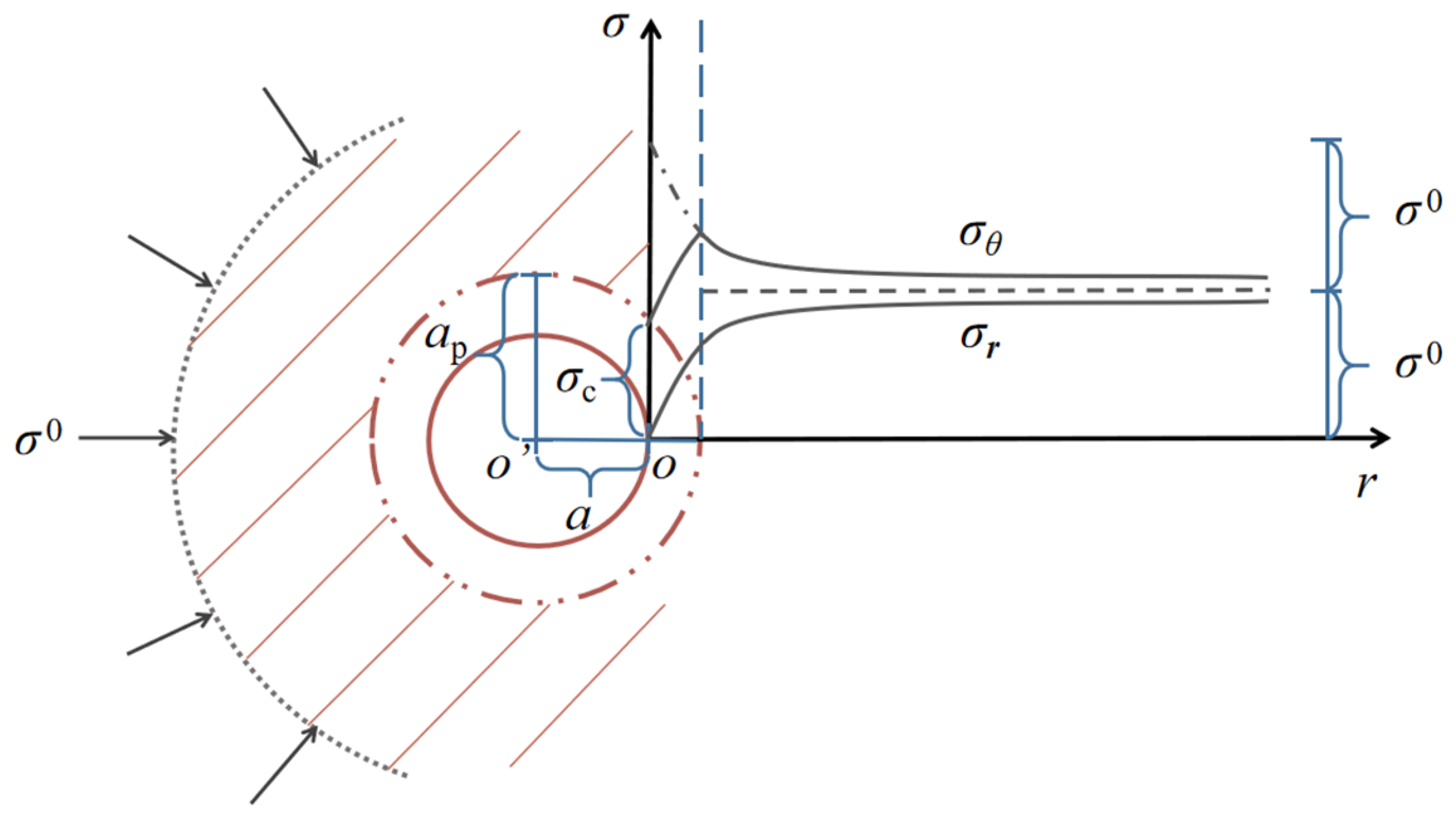

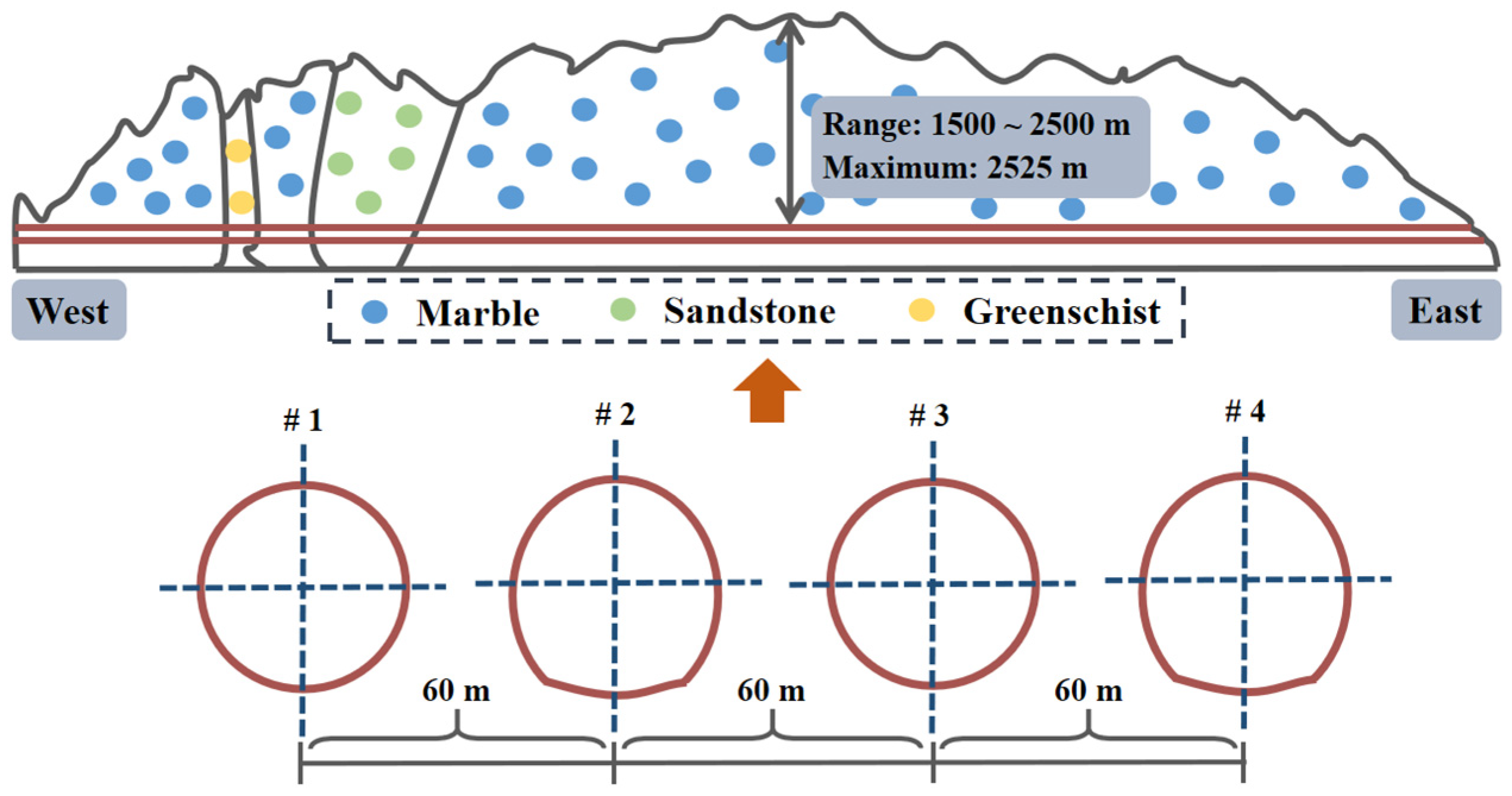

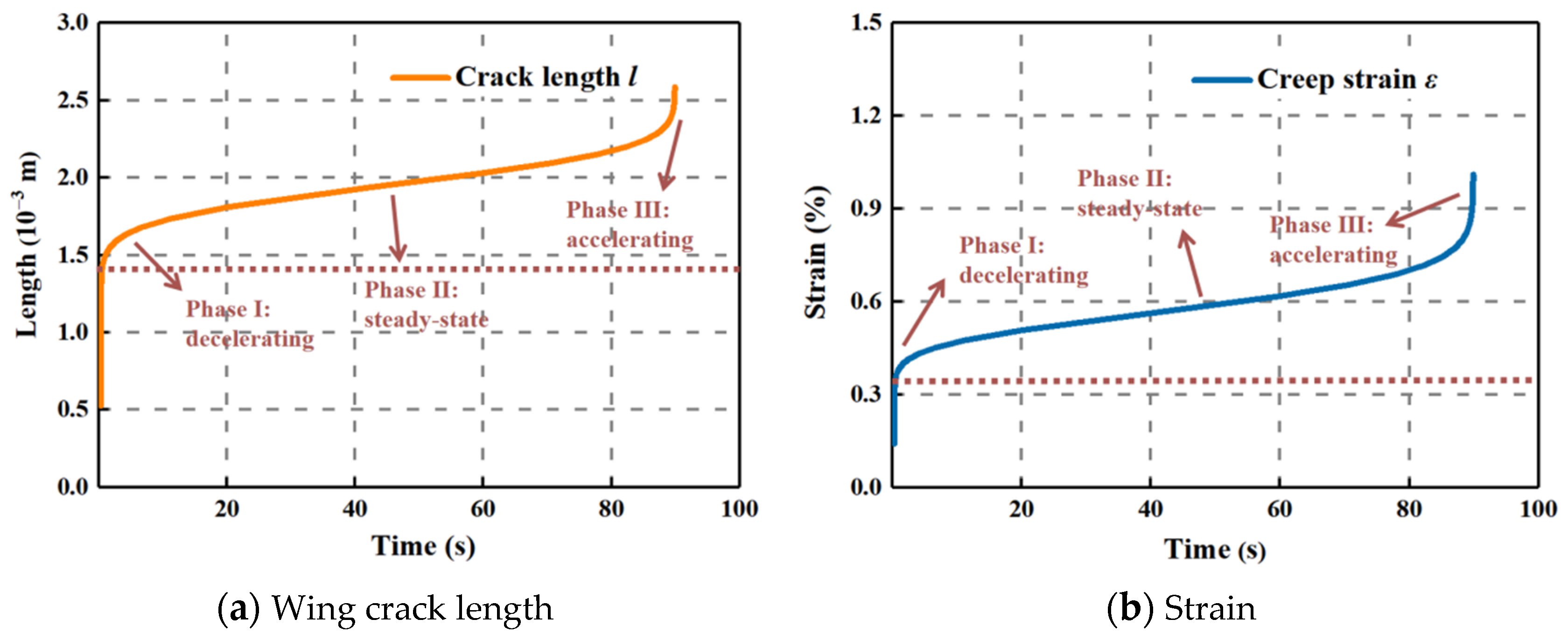
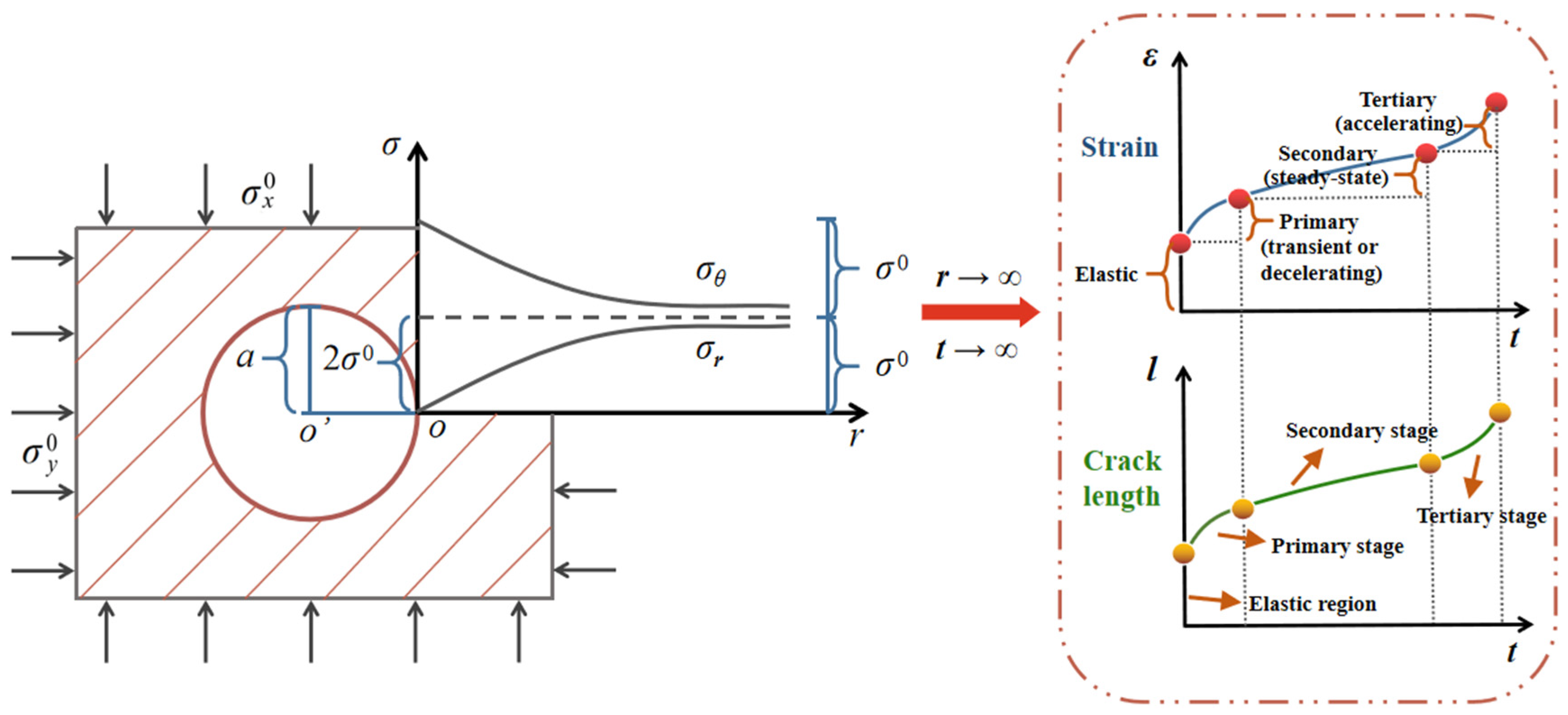



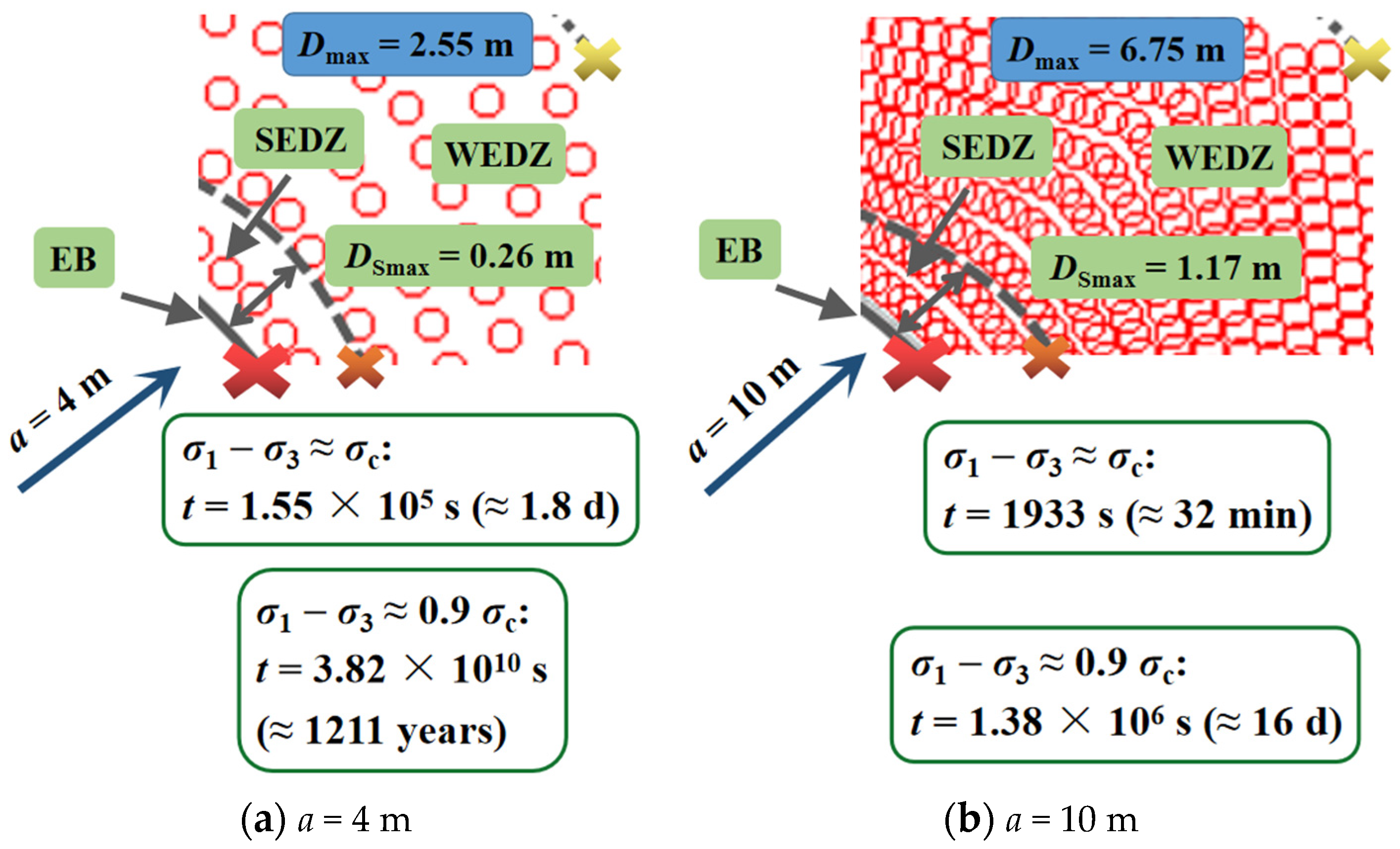

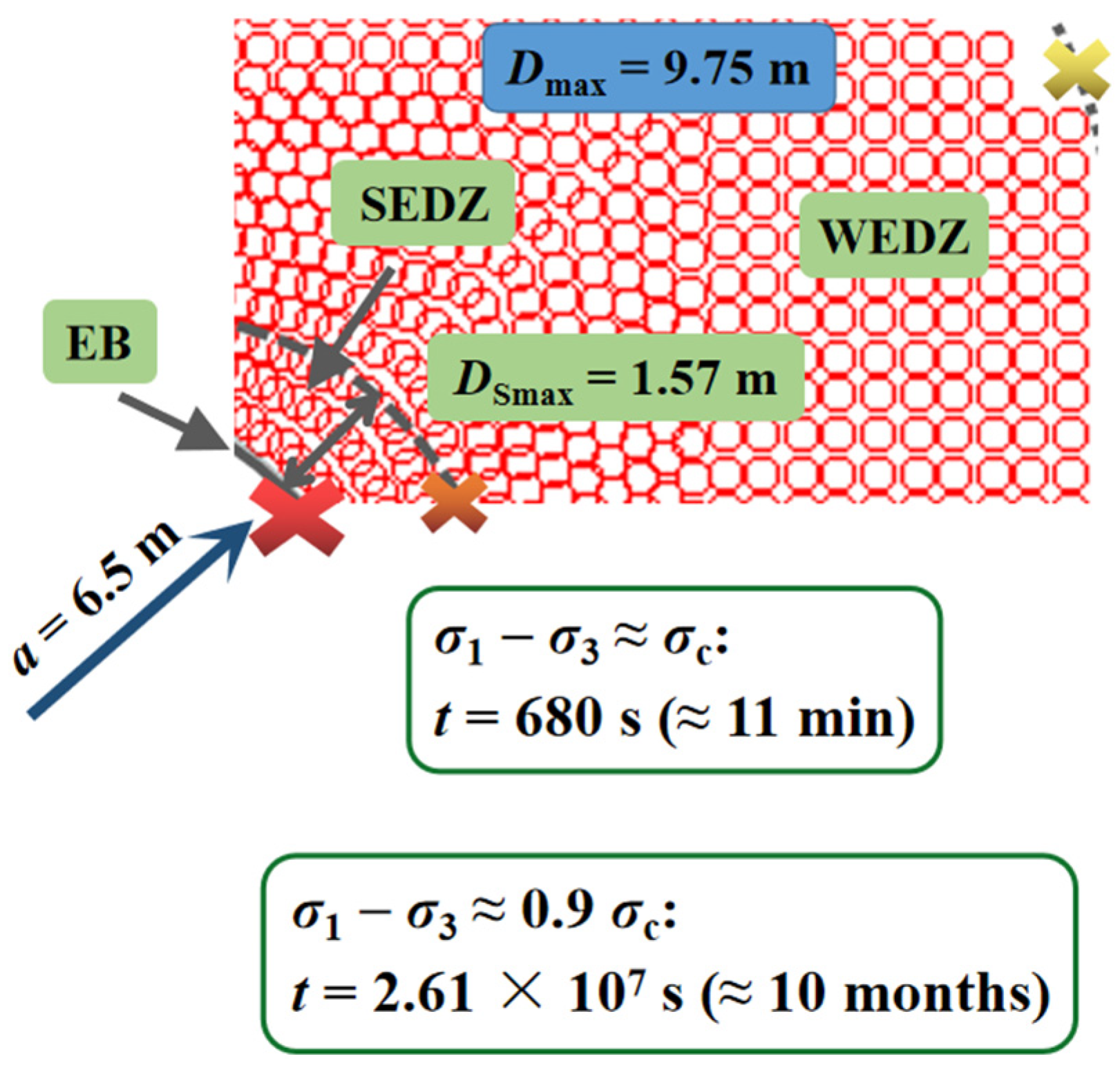
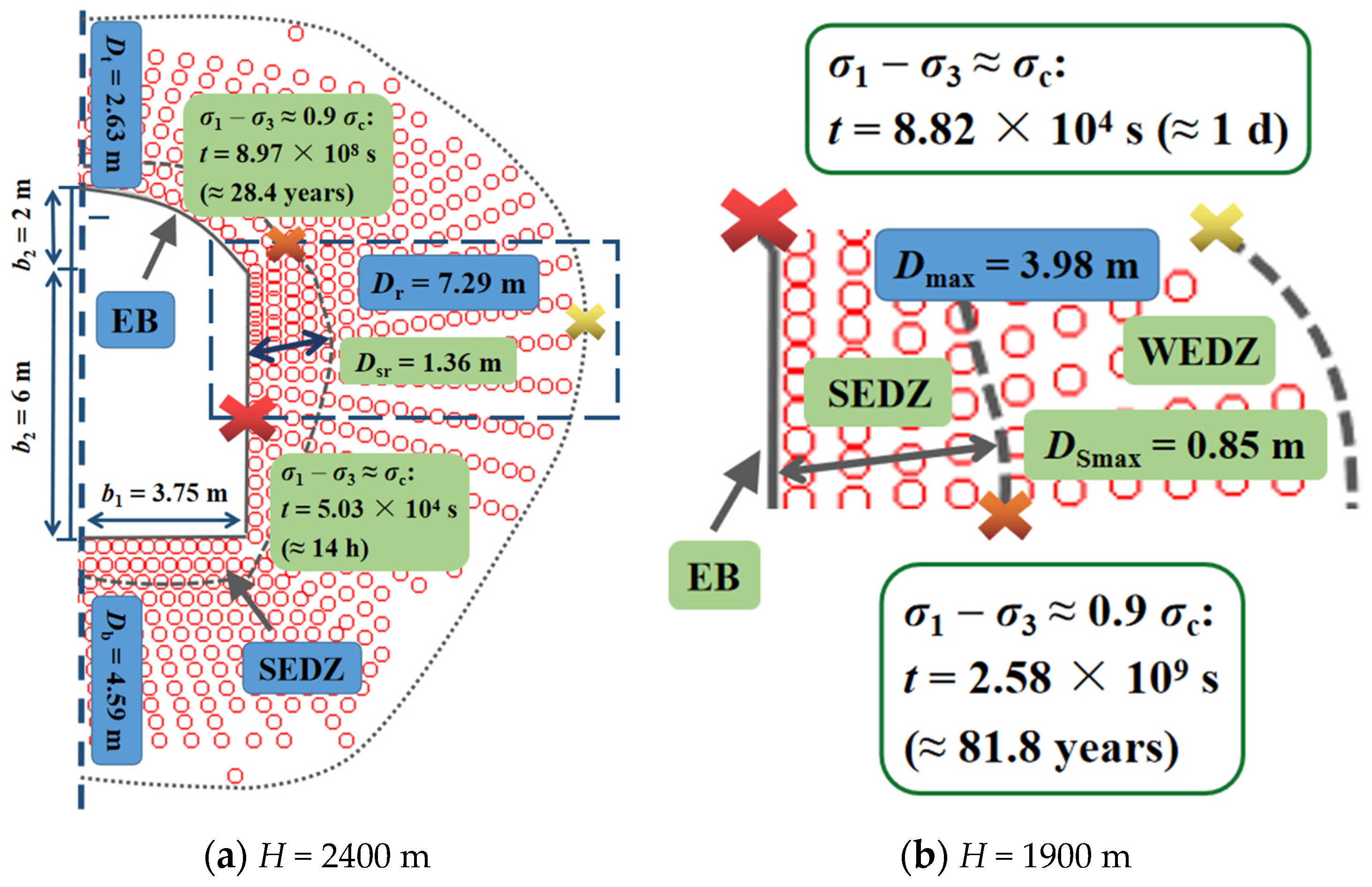
| Parameters | Specific Value |
|---|---|
| Short-term strength (σc/MPa) | 105 |
| Elastic modulus (E/GPa) | 25.3 |
| Internal friction angle (φ/°) | 22.7 |
| Cohesion (c/MPa) | 23.9 |
| Poisson’s ratio ν | 0.3 |
| Initial damage D0 | 0.048 |
| Fracture toughness (KIC/MPa m1/2) | 1.61 |
| Index of stress corrosion n | 57 |
| Characteristic crack velocity (v/m s−1) | 0.16 |
| Initial crack size (b/m) | 0.00305 |
| Friction coefficient μ | 0.51 |
| Microcrack angle (ψ/°) | 45 |
| Constant β | 0.32 |
| Material constant m | 1 |
| Material constant ε0 | 0.015 |
| Initial equilibrium crack length (l0/m) | 0.0038 |
Publisher’s Note: MDPI stays neutral with regard to jurisdictional claims in published maps and institutional affiliations. |
© 2022 by the authors. Licensee MDPI, Basel, Switzerland. This article is an open access article distributed under the terms and conditions of the Creative Commons Attribution (CC BY) license (https://creativecommons.org/licenses/by/4.0/).
Share and Cite
Chen, H.; Shao, Z.; Zhang, Z. Impact of Brittle Creep Failure on Time-Delayed Characteristics of Rockburst. Materials 2022, 15, 3035. https://doi.org/10.3390/ma15093035
Chen H, Shao Z, Zhang Z. Impact of Brittle Creep Failure on Time-Delayed Characteristics of Rockburst. Materials. 2022; 15(9):3035. https://doi.org/10.3390/ma15093035
Chicago/Turabian StyleChen, Haozhe, Zhushan Shao, and Zhe Zhang. 2022. "Impact of Brittle Creep Failure on Time-Delayed Characteristics of Rockburst" Materials 15, no. 9: 3035. https://doi.org/10.3390/ma15093035
APA StyleChen, H., Shao, Z., & Zhang, Z. (2022). Impact of Brittle Creep Failure on Time-Delayed Characteristics of Rockburst. Materials, 15(9), 3035. https://doi.org/10.3390/ma15093035





